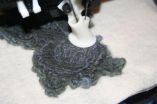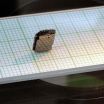(Press-News.org) An international team of researchers has found that a subset of common butterfly species are emerging later than usual in urban areas located in warmer regions, raising questions about how the insects respond to significant increases in temperature.
"We know that butterflies emerge earlier in North Carolina than they do in New England, because it's warmer," says Tyson Wepprich, a Ph.D. student at NC State and co-author of a paper describing the work. "We also know that cities are heat sinks that are warmer than outlying areas. So we wanted to see whether butterflies would emerge earlier in cities than they do in more rural environments."
To address the question, the research team focused on 20 of the most common butterfly species found in Ohio. The team used data from the Ohio Lepidopterists' Society, whose volunteers monitor butterfly populations at sites across Ohio every week from April through October. The work was done by researchers at North Carolina State University, Case Western Reserve University, the Instituto de Pesquisas Ecológicas in Brazil, and the University of Maryland.
The researchers used the Ohio monitoring data from the years 1996 to 2011 to establish when each species emerged at each site every year, when each species' population numbers peaked at each site every year, and the last recorded observation of each species at each site every year. The researchers also looked at the temperature and urban density around each monitoring site.
There was a wide range of responses to urbanization across species, but one finding stood out.
"The combined effect of an urban area and a warmer part of the state appeared to delay emergence in seven of the 20 species," Wepprich says.
The affected species in these areas, including the Eastern Tiger Swallowtail, emerged days or weeks after other butterflies of the same species emerged in either rural areas in the warmer parts of Ohio, or urban areas in colder parts of Ohio.
"Even though butterflies often change their emergence predictably to small increases in temperature, these species responded in unexpected ways to larger increases in temperature," Wepprich says.
"Scientists often use analogies for global climate change, such as urban warming, to understand how species' might respond to a warmer future," Wepprich adds. "This allows us to estimate which species are more vulnerable to climate change.
"We don't really know precisely where the tipping point is, or why only some species respond this way, but something is happening here. We're still working to better understand what's going on with these butterfly species and what consequences there may be for their populations."
INFORMATION:
The paper, "Unexpected phenological responses of butterflies to the interaction of urbanization and geographic temperature," is published online in the journal Ecology. Lead author of the paper is Sarah Diamond, an assistant professor at Case Western and former postdoctoral researcher at NC State. Co-authors include Heather Cayton, Rob Dunn and Nick Haddad of NC State; Clinton Jenkins of the Instituto de Pesquisas Ecológicas; and Leslie Ries at the University of Maryland.
The work was supported by the Department of the Interior's Southeast Climate Science Center, which is based at NC State; U.S. Geological Survey grant G10AC00624; Department of Energy grant DE-FG02-08ER64510; and grants from the National Science Foundation, NASA, and the Brazilian agency CAPES.
Urbanization, higher temperatures can influence butterfly emergence patterns
2014-04-28
ELSE PRESS RELEASES FROM THIS DATE:
Basel Egyptologists identify tomb of royal children
2014-04-28
Who had the privilege to spend eternal life next to the pharaoh? Close to the royal tombs in the Egyptian Valley of the Kings, excavations by Egyptologists from the University of Basel have identified the burial place of several children as well as other family members of two pharaohs.
Basel Egyptologists of the University of Basel Kings' Valley Project have been working on tomb KV 40 in the Valley of the Kings close to the city of Luxor for three years. From the outside, only a depression in the ground indicated the presence of a subterranean tomb. Up to now, nothing ...
Criminal behavior: Older siblings strongly sway younger siblings close in age
2014-04-28
If a sibling commits a violent criminal act, the risk that a younger sibling may follow in their footsteps is more likely than the transmission of that behavior to an older sibling, according to a new study conducted by researchers at Virginia Commonwealth University and Lund University in Sweden.
The findings provide insight into the social transmission of violent behaviors and suggest that environmental factors within families can be important when it comes to delinquent behavior. Down the road, the results may be used to inform strategies for prevention and treatment ...
Research shows smartphone sensors leave trackable fingerprints
2014-04-28
Research at the University of Illinois has demonstrated that smartphone sensors — not just the ones meant to track your location — can leave real-time fingerprints unique to each individual device. An attacker could use such sensor data from a given smartphone to identify it ever after, almost making the user-trackable.
Research by Electrical and Computer Engineering Associate Professor Romit Roy Choudhury and graduate students Sanorita Dey and Nirupam Roy, demonstrated that these fingerprints exist within smartphone sensors, mainly because of imperfections during the ...
Carnegie Mellon-Disney researcher invents 3D printing technique for making cuddly stuff
2014-04-28
PITTSBURGH—Soft and cuddly aren't words used to describe the plastic or metal things typically produced by today's 3D printers. But a new type of printer developed by Carnegie Mellon University and Disney Research Pittsburgh can turn wool and wool blend yarns into fabric objects that people might actually enjoy touching.
The device looks something like a cross between a 3D printer and a sewing machine and produces 3D objects made of a form of loose felt. Scott Hudson, a professor in CMU's Human-Computer Interaction Institute who developed the felting printer with Disney ...
Beyond graphene: Controlling properties of 2D materials
2014-04-28
The isolation of graphene at the University in 2004 led to the discovery of many other 2D crystals. While graphene has an unrivalled set of superlatives, these crystals cover a large range of properties: from the most conductive to isolating, from transparent to optically active.
The next step is to combine several of these crystals in a 3D stack. This way, one can create 'heterostructures' with novel functionalities – capable of delivering applications as yet beyond the imagination of scientists and commercial partners.
The first examples of such heterostructures already ...
One cell type may quash tumor vaccines
2014-04-28
(PHILADELPHIA) -- Most cancer vaccines have not lived up to their promise in clinical trials. The reason, many researchers suspect, is that the immune cells that would help the body destroy the tumor – even those reactions boosted by cancer vaccines – are actively suppressed. Now, researchers at Thomas Jefferson University have found that a single cell type is actively suppressed in several experimental cancer vaccines, paving the way toward methods to break suppression and improve the effectiveness of cancer vaccines. The work was published this week online in the European ...
Ames Lab researchers see rare-earth-like magnetic properties in iron
2014-04-28
Scientists at the Department of Energy's Ames Laboratory have observed magnetic properties typically associated with those observed in rare-earth elements in iron. These properties are observed in a new iron based compound that does not contain rare earth elements, when the iron atom is positioned between two nitrogen atoms. The discovery opens the possibility of using iron to provide both the magnetism and permanence in high-strength permanent magnets, like those used in direct-drive wind turbines or electric motors in hybrid cars. The results appeared in Nature Communications.
In ...
Estimating baby's size gets more precise
2014-04-28
New Michigan State University research aims to help doctors estimate the size of newborns with a new set of birth weight measurements based on birth records from across the country.
"More than 7 million records were reviewed," said Nicole Talge, an assistant professor in MSU's Department of Epidemiology and Biostatistics, who co-led the study which is now available in the journal Pediatrics.
"Our research looked at live births in the United States during 2009-2010 and using a newly developed method, corrected unlikely gestational ages during that time. This led to changes ...
Gulf War illness: New report lauds treatment research, confirms toxic causes
2014-04-28
Progress has been made toward understanding the physiological mechanisms that underlie Gulf War illness and identifying possible treatments, according to a report released Monday by a Congressionally mandated panel of scientific experts and veterans.
Treatment research has increased significantly since 2008, and "early results provide encouraging signs that the treatment goals identified in the 2010 Institute of Medicine report are achievable," the Research Advisory Committee on Gulf War Veterans' Illnesses (RAC) said in a report presented Monday to VA Secretary Eric ...
Studies offer insight on how to improve kidney and liver transplantation
2014-04-28
The quality of kidney and liver donations is fundamentally important for the longevity of transplants and the health of recipients. That's why it's critical to know which organs are suitable for transplantation, as well as to use techniques that preserve an organ's function after donation. Several studies published in the BJS (British Journal of Surgery) address these issues and offer ways to maximize the use of donated organs.
In the first study, Rajeev Desai, MRCP, of NHS Blood and Transplant, in the UK, led a team that assessed transplants from 17,639 donors, including ...




